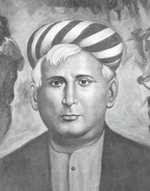
Name: Bankim Chandra Chatterjee
DOB: June 26, 1838
Date of Death: April 8, 1894
Introduction:
Bankim Chandra Chatterjee was educated at the Hoogly College and belonged to an orthodox family. He was offered the government post of Deputy Magistrate and Collector which he accepted and held until he retired 1891.
Chatterjee, following the discipline of Isvarchandra Gupta, began his literary career as a writer of verse. His first attempt was a novel in Bengali submitted for a declared prize. The prize did not come to him and the novelette was never published. His first fiction to appear in print was Rajmohan's Wife. Durgeshnandini, his first Bengali romance, was published in 1865. The next novel Kapalkundala (1866) is one of the best romances written by Chatterjee.
The next romance Mrinalini (1869) indicates an ameturishness and a definite falling off from the standard.
The next novel Rajani (1877) followed the autobiographical technique of Wilkie Collins' A Woman in White. The title role was modelled after Bulwar Lytton's Nydia in Last Days of Pompeii. In this romance of a blind girl, Chatterjee is at his best as a literary artist. In Krishnakanter Uil (Krishnakanta's Will, 1878) Chatterjee added some amount of feeling to imagination, and as a result it approaches nearest to the western novel. The only novel of Chatterjee's that can claim full recognition as historical fiction is Rajsimha (1881, rewritten and enlarged 1893). Anandamath (The mission house of the Anandas, 1882) is a political novel without a sufficient plot. It definitely marks the decline of Chatterjee's power as a novelist. The plot of the meagre story is based on the Sannyasi rebellion that occurred in North Bengal in 1773. As fiction it can not be called an outstanding work. But as the book that interpreted and illustrated the gospel of patriotism and gave Bengal the song "Bande Mataram" (I worship mother) which became the mantra of nationalism and the national song.
Devi Caudhurani by Chatterjee was published in 1884. The story is romantic and interesting and delightfully told, no doubt. Chatterjee's last novel Sitaram (1886) has for its theme the insurgence of a Hindu chief of lower central Bengal against the impotent Muslim rule. The central figure is well delineated but the other figures are either too idealistic or impalpable.
After the novels, the humorous sketches are the outstanding productions of Chatterjee. Kamalakanter Daptar (The Scribbling of Kamalakanta, 1875; enlarged as Kamalakanta, 1885) contains half humorous and half serious sketches somewhat after De Quincey's Confessions of an English Opium-eater. It shows the writer at his best.
Bankim Chatterjee was superb story-teller, and a master of romance. He is also a great novelist in spite of the fact that his outlook on life was neither deep nor critical, nor was his canvas wide. But he was something more than a great novelist.

No comments:
Post a Comment